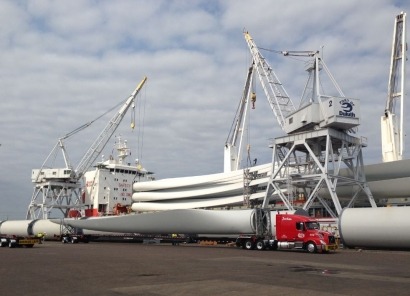
“During the month of August, high value project cargo was on the move throughout the Great Lakes-St. Lawrence Seaway System,” said Betty Sutton, administrator of the Saint Lawrence Seaway Development Corporation.
“Ships carried oversized cargo of wind components like towers, nacelles, blades and hubs; machinery, generators, and refinery equipment to the Ports of Cleveland, Toledo and Duluth," Sutton continued. "Clearly shippers chose to move heavy lift cargo via the Seaway System because of the economic benefits, safety and reliability of our waterway and its direct access to the heartland of North America.”
It has been an extremely busy summer for heavy-lift and project cargo handling in the Port of Duluth.
Four of nearly two dozen vessels expected this year arrived in August to discharge wind turbine towers, nacelles and 49-meter blades for ALLETE Clean Energy’s Thunder Spirit wind farm in North Dakota, plus components for that state’s oil and gas industry.
“We anticipate closing out this season on a high note here at the Clure Public Marine Terminal,” said Vanta Coda, executive director of the Duluth Seaway Port Authority. “There are another five ships on the horizon scheduled for later this fall, serving the wind, oil and gas, and pulp/paper industries in North America’s Heartland.”
Of course, wind components werenm't the only energy-related cargo moving through the seaway. The Port of Toledo. for instance, enjoyed a very good summer handling cargo for the regional oil and gas industry.
“Many of the project cargo shipments via the Seaway are in support of the regional oil and gas industry,” said Joe Cappel, vice president of business bevelopment for the Toledo-Lucas County Port Authority.
In August the port welcomed the BBC Ohio, delivering cargo for Husky’s Lima refinery, to her namesake state. Siemens natural gas turbines shipped from Charleston, South Carolina arrived in Toledo later in the month on the barge Sea Cresent for a new power plant in Oregon, Ohio.
“In addition to project cargo handling at our general cargo facility, we are trans-loading oil and gas products at our new Ironville terminal from rail to truck. This is a great example of the diverse cargo handling capabilities of our stevedore, Midwest Terminals, and the importance of having unit train capacity and good intermodal connectivity,” Cappel said.
The St. Lawrence Seaway reported that year-to-date total cargo shipments for the period 2 April to 31 August were 18.3 million metric tons, down 10.6 percent over the same period in 2014.
For additional information:

